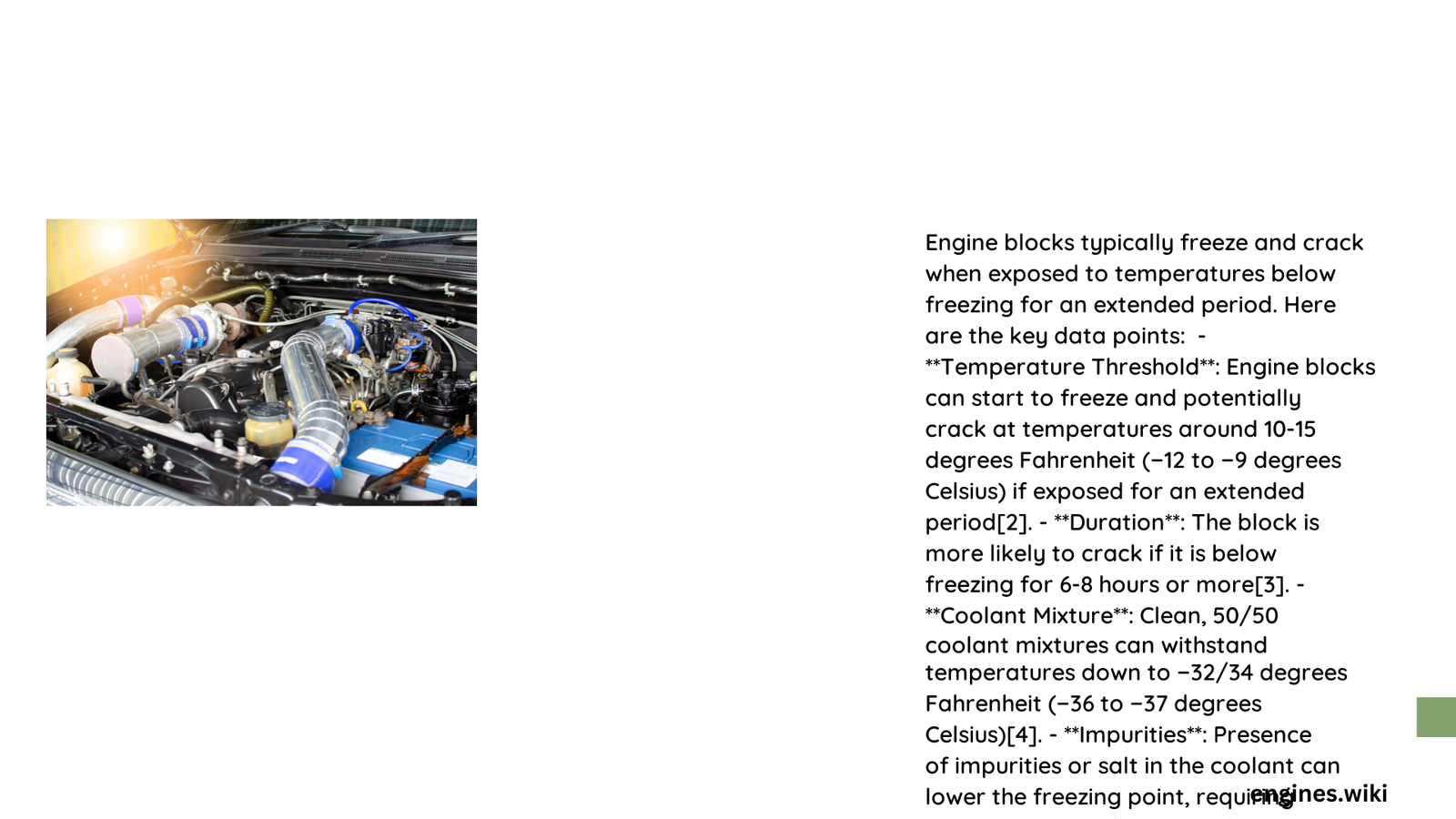Vehicle engines are vulnerable to extreme cold temperatures, with potential catastrophic damage occurring when coolant freezes. Understanding precisely how cold an engine block can withstand before critical failure is essential for automotive preservation. Temperatures approaching and below 32°F (0°C) pose significant risks, especially when antifreeze concentration is inadequate.
What Temperature Causes Engine Block Freezing?
Engine block freezing is a complex phenomenon influenced by multiple factors. The fundamental freezing point depends on coolant composition and antifreeze concentration.
Core Freezing Temperature Factors
| Coolant Composition | Freeze Point | Protection Range |
|---|---|---|
| Pure Water | 32°F (0°C) | No protection |
| 25% Antifreeze | 20°F (-7°C) | Limited protection |
| 50% Antifreeze | 5°F (-15°C) | Moderate protection |
| 70% Antifreeze | -40°F (-40°C) | Extreme protection |
Why Engine Blocks Freeze
Several critical mechanisms contribute to potential engine block freezing:
- Water Expansion: When water freezes, it expands approximately 9% in volume
- Pressure Build-up: Expansion creates immense internal pressure
- Material Stress: Aluminum and cast iron blocks can crack under extreme pressure
- Coolant Composition: Determines freeze resistance
Preventing Engine Block Freeze Damage

Antifreeze Selection Strategies
- Ethylene Glycol: Standard automotive antifreeze
- Propylene Glycol: Environmentally friendlier alternative
- Extended Life Coolants: Longer protection duration
Measurement Techniques
Vehicle owners can assess freeze protection through:
- Hydrometer Testing: Measures coolant density
- Refractometer Evaluation: Precise concentration measurement
- Professional Coolant Analysis: Comprehensive diagnostic approach
Critical Temperature Warning Signs
Indicators of Potential Freezing Risk
- Visual Coolant Inspection: Cloudy or discolored fluid
- Unusual Cooling System Behavior
- Unexpected Temperature Fluctuations
- Visible Ice Crystals
Recommended Maintenance Protocols
Winter Preparation Checklist
- Check antifreeze concentration
- Inspect cooling system components
- Replace worn hoses
- Verify thermostat functionality
- Maintain proper coolant levels
Technical Recommendations
Optimal Antifreeze Mixture
- Standard Recommendation: 50% antifreeze, 50% water
- Extreme Cold Regions: 70% antifreeze concentration
- Annual Coolant Replacement: Every 2-3 years
Potential Consequences of Inadequate Protection
Damage Scenarios
- Engine Block Cracking
- Cylinder Head Warping
- Radiator Rupture
- Coolant System Failure
Repair Cost Implications
Potential repair costs range from $500 to $4,000, depending on damage severity.
Professional Insights
Automotive engineers emphasize proactive maintenance as the most cost-effective strategy for preventing freeze-related damage. Regular inspections and timely coolant system management can significantly extend vehicle longevity.
Expert Recommendations
- Monitor coolant condition
- Use high-quality antifreeze
- Perform regular system diagnostics
- Address minor issues promptly
Conclusion
Understanding how cold an engine block can withstand requires comprehensive knowledge of coolant chemistry, vehicle design, and environmental conditions. Proper preparation and maintenance are key to preventing costly engine damage.
Final Protective Measures
- Maintain recommended antifreeze concentration
- Store vehicle in heated environments when possible
- Use block heaters in extreme conditions
- Conduct regular cooling system inspections
Reference:
– ChrisFix Coolant Guide
– Automotive Cooling Systems Research
– Engine Maintenance Protocols
